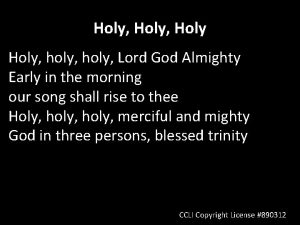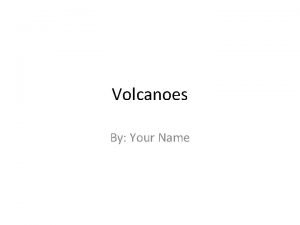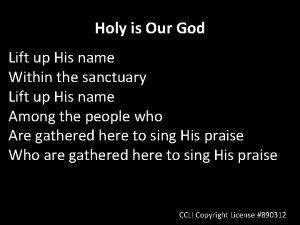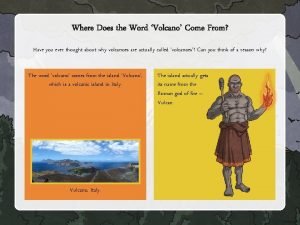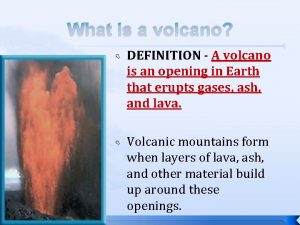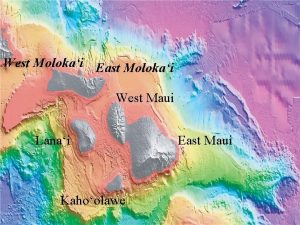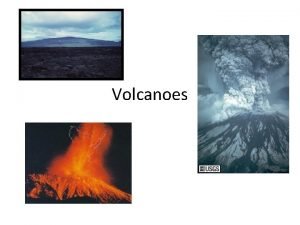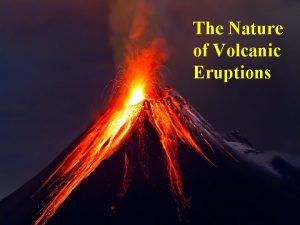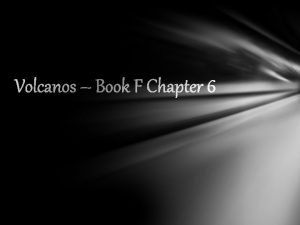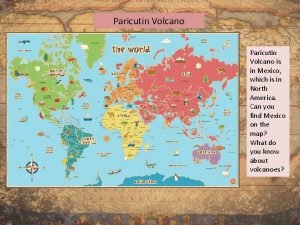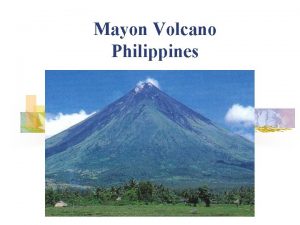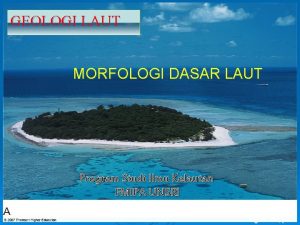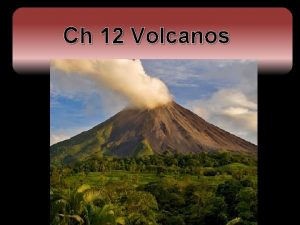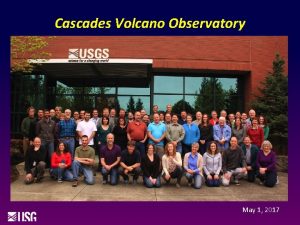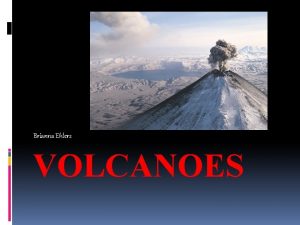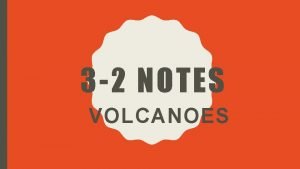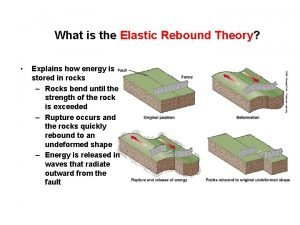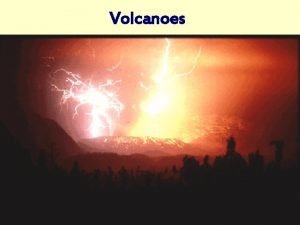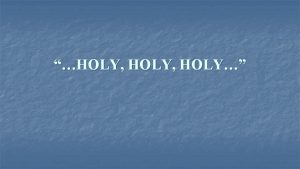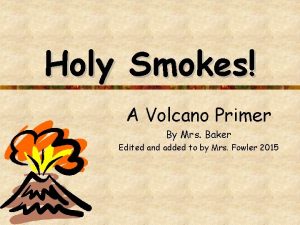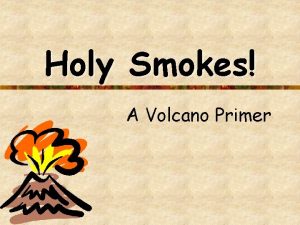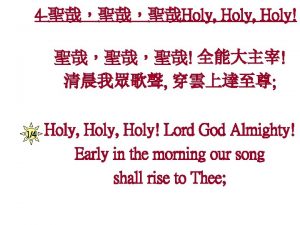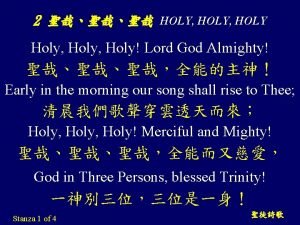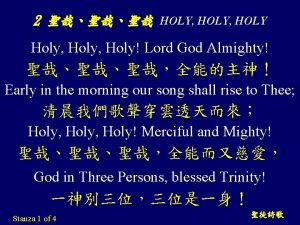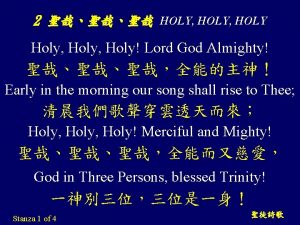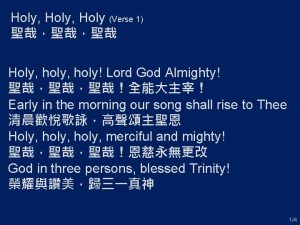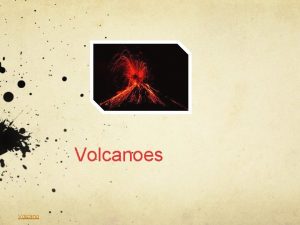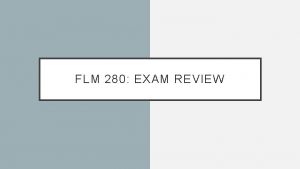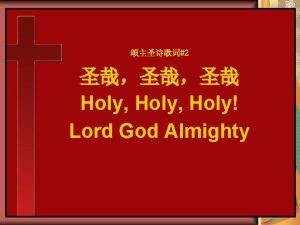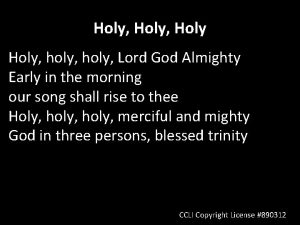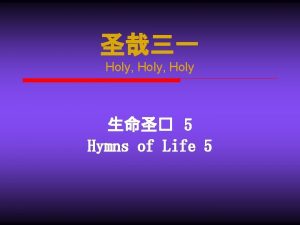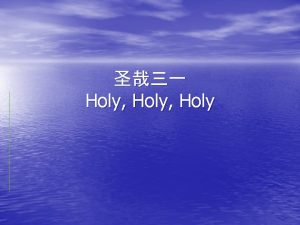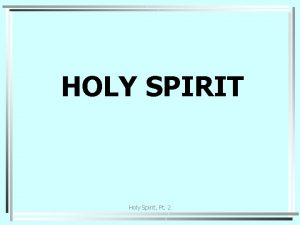Holy Smokes Volcano Classification What is a volcano

























- Slides: 25

Holy Smokes! Volcano Classification

What is a volcano? A volcano is an opening in Earth that erupts gases, ash, and lava. Volcanic mountains form when layers of lava, ash, and other material build up around these openings.

3 Basic Volcano shapes 1. Cinder Cone 2. Shield 3. Composite Cone

1. Cinder Cone Volcano Formed by Tephra (volcanic cinders, bit of solidified lava, and bits of rocks) thrown into the air during an eruption & then fall back down around the vent (volcanic opening) forming a steep-sided loosely packed volcano.

Example Cinder Cone Volcano Parícutin Volcano in Mexico is a great example of a cinder cone volcano.

Paracútin On February 20, 1943, a Mexican farmer noticed that a hole in his cornfield that had been there for as long as he could remember was giving off smoke. Throughout the night, hot glowing cinders were thrown high into the air. In just a few days, a cinder cone several hundred meters high covered his cornfield.

2. Shield Volcano Quiet eruptions of basaltic lava spread out in flat layers. The buildup of these layers forms a broad volcano with gently sloping sides.

Shield Volcano Mauna Kea volcano picture from www. usgs. gov The shapes of these volcanoes reflect the fact that they are constructed of lava flows that erupted non -explosively. It is usually many times larger than a composite cone or cinder cone volcano.

Example of Shield Volcano Mauna Loa Mt. Kilauea Probably one of the world’s most active volcanoes. The eruption of Kilauea Volcano that began in 1983 continues at the cinder-and-spatter cone. Mt. Kilauea Picture from http: //www. britannica. com/eb/art 89176/Hawaiis-Kilauea-is-an-active-volcano

3. Composite Volcano This type of volcano is composed of explosively erupted pyroclastic materials layered with lava flows and volcanic debris. An explosive period can release gas and ash, forming a tephra layer. Then, the eruption can switch to a quieter period, erupting lava over the top of the tephra layer.

Example of Composite Volcano Mount St. Helen’s Erupted in 1980 57 fatalities Over 7000 big game animals perished 4 billion board feet of timber (enough to build about 300, 000 two-bedroom homes) destroyed Destroyed 27 bridges, nearly 200 homes. Blast destroyed more than 185 miles of highways and roads and 15 miles of railways.

Example of Composite Volcano Mount Pinatubo Erupted in 1991 Killed 847 people 184 people injured 10, 000 home destroyed another 5, 000 were damaged. The ash cloud took one year to spread around the globe, reducing global temperatures. This resulted in Floods in 1993 along the Mississippi River Drought in Africa in 1993 The US had its 3 rd wettest & coldest winter on record.

Example of Composite Volcano Krakatau One of the most violent eruptions in recent times occurred on an island in the Sunda Straits near Indonesia in August of 1883. Krakatau, a volcano on the island, erupted with such force that the island disappeared.

Example of Composite Volcano Krakatau Killed 36, 000 people most were killed by a giant tsunami Destroyed 160 villages Fine ashes from the eruption were carried by upper level winds as far away as New York City Volcanic dust lowered global temperatures for five years.

What determines how explosive an eruption is? Amount of trapped gases Amount of Water Vapor Composition of Magma

1. Trapped Gases such as water vapor and carbon dioxide are trapped in magma by the pressure of the surrounding magma and rock. Gas escapes easily from some magma during quiet eruptions. However, gas that builds up to high pressures eventually causes explosive eruptions.

2. Amount of Water Vapor The magma at some convergent plate boundaries contains a lot of water vapor. This is because oceanic plate material and some of its water slide under other plate material at some convergent plate boundaries. The trapped water vapor in the magma can cause explosive eruptions.

3. Magma Composition The composition (what it is made of) determines how explosive a volcano will be.

Magma Composition Basaltic Magma made of basalt is very fluid, allowing trapped gases to escape easily. Volcanoes with basaltic lava have quiet, nonexplosive eruptions.

Magma Composition Basaltic Examples You can find volcanoes with basaltic lava Hawaiian Volcanoes, including Kilauea Mona Loa Iceland Heimaey Hekla

Magma Composition Granitic Lava Silica-rich, or granitic (also called rhyolite) magma produces explosive eruptions. Silica-rich granitic magma is thick, and gas gets trapped inside, causing pressure to build up.

Magma Composition Granitic Lava “If it had erupted in a populated area…"The magnitude of the eruption can perhaps be best realized if one could imagine a similar outburst centered in New York City. All of Greater New York would be buried under from ten to fifteen feet of ash; Philadelphia would be covered by a foot of gray ash and would be in total darkness for sixty hours; Washington and Buffalo would receive a quarter of an inch of ash, with a shorter period of darkness. The sound of the explosion would be heard in Atlanta and St. Louis, and the fumes noticed as far away as Denver, San Antonio, and Jamaica. " Some examples of granitic volcanoes are Yellowstone Caldera It is a super voclano! Katmai, Alaska Last eruted in 1912.

Volcanoes in a nutshell Three volcano types Shape Cinder Violent eruptions Composite Violent & quiet eruptions Shield Quiet Eruptions

Volcanoes in a nutshell Three factors affect how violent an eruption will be Water Vapor More water vapor = bigger explosion Trapped Gasses How easily the gas escapes determines how violent the explosion Easy escape = quiet eruption Difficult to escape = explosive eruption Magma Type Basaltic Magma = quiet explosion Granitic = violent eruptions-Silica rich lava

Resources used Volcano World http: //volcano. und. edu/ US Geologic Survey http: //www. usgs. gov/ Glencoe Earth Materials & Processes
 Holy holy holy lord god almighty
Holy holy holy lord god almighty Holy are you lord
Holy are you lord Andrea is a very good student. the probability
Andrea is a very good student. the probability Lava plateaus form when _____.
Lava plateaus form when _____. Holy spirit meaning
Holy spirit meaning Be holy as i am holy
Be holy as i am holy Holy holy lift up his name
Holy holy lift up his name Holyhol
Holyhol Deuteronomy 20:8
Deuteronomy 20:8 Where does the word “volcano” come from
Where does the word “volcano” come from Composite cone definition
Composite cone definition Lanai volcano
Lanai volcano Which volcano
Which volcano Magma
Magma Steep sided volcano made of loosely packed tephra
Steep sided volcano made of loosely packed tephra Paricutin volcano facts
Paricutin volcano facts How to find p value from t statistic
How to find p value from t statistic Characteristics of mayon volcano
Characteristics of mayon volcano Solidified scum from the surface of the lava is called as
Solidified scum from the surface of the lava is called as Volcano abisal adalah
Volcano abisal adalah Steep-sided volcano made of loosely packed tephra
Steep-sided volcano made of loosely packed tephra Cascade volcano observatory
Cascade volcano observatory Cylinder cone volcano
Cylinder cone volcano Notes from a volcano
Notes from a volcano What does the elastic rebound theory explains?
What does the elastic rebound theory explains? Big island size broad slightly domed volcano
Big island size broad slightly domed volcano
